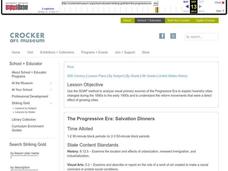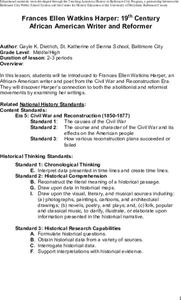Curated OER
The Progressive Era
Eighth graders utilize the SOAP method to analyze a work of art and relate it to what they know about the Progressive Era and the reasons why cities changed and the ways in which cities changed during the end of the 19th century. They...
Center for History Education
Frances Ellen Watkins Harper: 19th Century African-American Writer and Reformer
Although some African American abolitionists—such as Sojourner Truth and Frederick Douglass—are well known, others, like Frances Ellen Watkins Harper, remain in the shadows of history. Harper was a poet and activist who played an...
C3 Teachers
Women’s Rights: What Does It Mean to Be Equal?
A guided-inquiry lesson asks seventh graders to research the compelling question, "What does it mean to be equal?" Guided by three supporting questions, researchers complete three formative performance tasks and gather evidence from...
City University of New York
African Americans and the Populist Movement
Why did the Populist Party fail to ally itself with African American farmers? To answer this essential question, class members investigate the Populist Era (188-1900) and read an article written by Tom Watson, a Populist leader.
Curated OER
Frances Ellen Watkins Harper: 19th Century African-American Writer and Reformer
Students investigate African-American author Frances Ellen Watkins Harper by analyzing her life and poetry. They explore the reformist messages communicated in her writings and evaluate the potential impact of her work.
NPR
Progressive Era Lesson Plan
The women working for equal rights in the early 20th century weren't a part of one large group; rather, they were members of dozens of small groups focused on social reform. Explore the ways groups in the Progressive Era like National...
Curated OER
John Gary Evans and the Politics of Race
Young scholars read letters written by Evans and Gunton regarding race relations. In this Progressive Movement lesson, students interpret the intentions and tone of the letters to understand contemporary racial beliefs. Young scholars...
National First Ladies' Library
Gibson Girls and Flappers: What is this "New Woman"?
Students divide into five groups with each exploring one section of the website, "The New Woman". After they complete their research, they discuss the nature and characteristics of the "new woman" and compare these to characteristics of...
Constitutional Rights Foundation
The Election of 1912
The Election of 1912: an election with four competitive opponents. Pupils get to know the candidates with informative reading passages that provide context to the election. Then, the class engages in a debate and answers questions as one...
Curated OER
Prudence Crandall House and Little Rock High School
Students examine how Prudence Crandall influenced the education of African Americans in New England prior to the Civil War and compare and contrast events in Canterbury, CN in the 1830's to those in Little Rock, AR in the 1950's.









